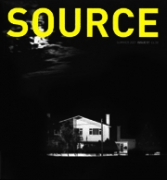This Morning There Was No New Idea
Maeve Rendle: Mount Purgatory Apartment, Manchester 2007
Review by Pavel Büchler
Issue 51 Summer 2007
View Contents ▸
In the appreciation of a work of art, the familiarity with the artist's intentions seldom proves helpful. With Maeve Rendle, it becomes an outright hindrance. No matter how I try to engage on my own critical terms with what she makes, I cannot forget that what she makes is, for Rendle, not the work. So, what is it? And how do I reconcile my understanding of the artist's argument with the experience of - why not use the word - the work?
The argument goes like this: the artist undertakes a mundane task which usually involves a physical manipulation of something readily available in her surroundings. The task has no predetermined objective nor are there any criteria for its execution. The activity creates, in her words, a 'thinking environment' in which 'the work begins to emerge'. The intention is not to produce a new reality - hence there cannot be a work as such - but to put the idea of 'the work' to work in the reality of thinking. She acts as if the work already had an identity and the sole purpose of her actions was to demonstrate its potential.
There is a result, of course, or a residue: a sequence of snapshots taken in the process. Photographically, they are both unremarkable (badly exposed, often blurred) and rather intriguing. They seem like random photographic accidents, without a subject, purpose or logic, and without any sense of singularity. Even where Rendle's photographs may repeatedly focus on a discrete object, they display no particular interest in it and there is no evident effort on the part of the photographer to convey information. And yet, arranged next to one another, they present a compelling account of photography's power to incite curiosity. Their very ambivalence becomes a source of wonder and the frustrating question of intentionality (why would anyone take pictures like these?), reveals quite a fascinating challenge to classification: what do I mean by 'pictures like these'?
In so far as Rendle's photographs are recordings of a studio activity, they belong to the tradition of performance for the camera pioneered in the 70s by Vito Acconci and Bruce Nauman. But while they share with such conceptual antecedents an ostensive disregard for the visual aesthetics of the photographic art, they are decidedly not a dispassionate 'documentation' of immaterial performative 'works'. They seem to testify to the possibilities and limitations of their own photographic condition, rather than providing a factual account of an external creative act. Nor do these strange pictures comfortably fit the developing fashions of the 'post-critical' artistic explorations of the arbitrary. For that, they are far too much like documents after all. But documents of what?
For her project Mount Purgatory, Rendle committed herself to a quixotically ambitious task. Over a period of a week 'in residence' in the domestic setting of Manchester's Apartment - a one-bedroom council flat-cum-artists run space - she stripped the place bare, packed away the owner's belongings, dismantled fixtures and fittings, unhinged the doors and took down the shelves, only to return everything to its former place by the time the owner-gallerist returned back from his self-imposed exile on a neighbour's sofa. Somehow, between filling cardboard boxes with kitchen utensils, books and socks, deciding where to put a five-litre tub of emulsion paint and wrapping the washing machine in plastic sheeting, she found the time every day for a tea break with The Guardian. In the series of about ninety photographs she took of the growing mayhem in the living room, the newspaper features almost from the start. It appears, sporadically at first, sometimes almost out of sight, on a coffee table next to a small old-fashioned chandelier and something that looks like a loose caster wheel that had fallen off a piece of furniture - exactly the sort of things that you never know where to put when you are packing to move. As the series progresses, the growing stack of newspapers moves from the periphery of the viewfinder centre stage, until, quite abruptly, a detail of a newspaper page fills the frame. In each of the next few frames, a word or two is highlighted on the printed page, gradually articulating the sentence 'this morning there was no new idea'. Then, the camera moves back again, as if contemplating a job half-done, before the sequence concludes with a step-by-step account of the newspapers being neatly wrapped in brown parcel paper, almost in the manner of an illustrated DIY manual.
For the presentation of - let me call it - 'the work' a month or so later, Rendle once again emptied the apartment's living room and mounted her pictures, edge to edge, in a continuous line high up on the walls. In this somewhat uncomfortable viewing arrangement, the photographs explicitly become a configuration of objects, what Vilém Flusser called, in a term borrowed from Wittgenstein, 'states of things': both documents of what took place and new material facts. This, in turn, puts an emphasis onto the complicated relational bond in photography between the recording and transformation of the world, 'the state of affairs', in which the photograph originates and to which it returns.
What emerges through Rendle's efforts is, then, not so much the abstract work, as an unexpected state of the world which gives the work its meaning. As a meditation on the potential of 'the work', it is as defeatist as it is defiant. And it works.
Other articles by Pavel Büchler:
Other articles mentioning Pavel Büchler:
Other articles on photography from the 'Conceptual' category ▸






